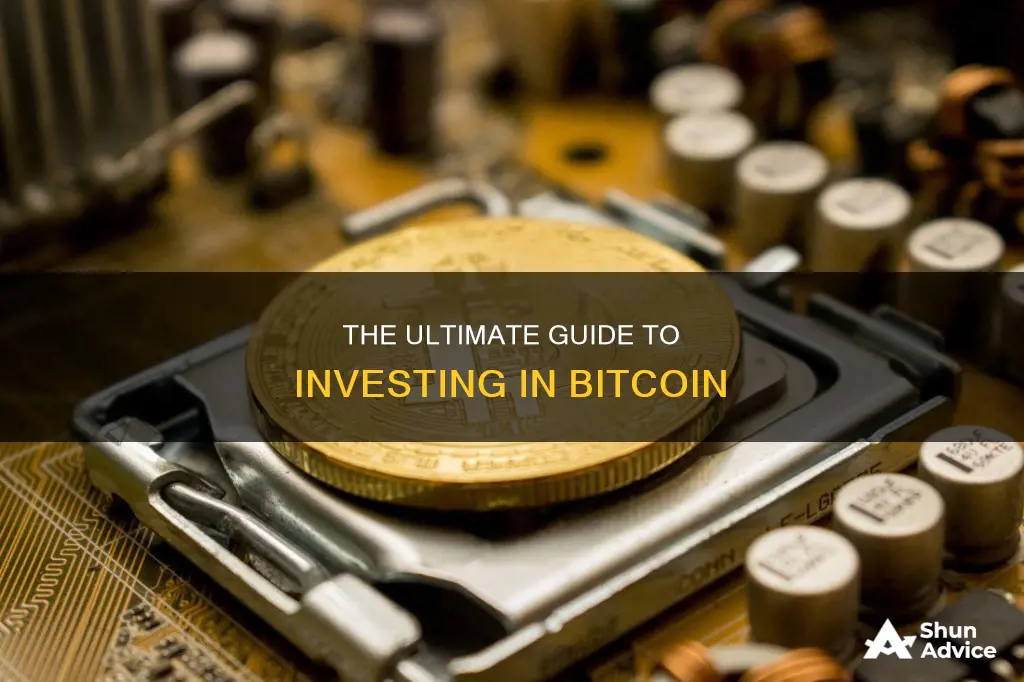
Bitcoin is a cryptocurrency that has become increasingly popular among investors in recent years. It was created by a programmer or group of programmers using the name Satoshi Nakamoto, but the real creator(s) remain unknown. Bitcoin is designed to prevent crypto coins from being fraudulently duplicated, and it uses blockchain technology to do so.
There are several ways to invest in Bitcoin, and the first step is to join a Bitcoin exchange such as Coinbase, Binance, Kraken, Gemini, or Bitfinex. After that, investors need to get a Bitcoin wallet, which can be a hot wallet or a cold wallet. A hot wallet is operated by a cryptocurrency exchange or provider and is more convenient, while a cold wallet is a physical piece of hardware that provides more security.
Once the wallet is set up and linked to a bank account, investors can place their Bitcoin order. It's important to note that investing in Bitcoin is very risky due to its high volatility, and investors should carefully consider their risk tolerance and investment strategy before purchasing.
| Characteristics | Values |
|---|---|
| How to buy Bitcoin | Via a cryptocurrency exchange, traditional stockbroker, money transfer app, Bitcoin ATM, or Bitcoin ETF |
| Cryptocurrency exchanges | Gemini, Kraken, Coinbase, Crypto.com, Uphold, Bitstamp, Binance, eToro, Kraken, Bitfinex |
| Traditional stockbrokers | Robinhood, Webull, TradeStation, Fidelity |
| Money transfer apps | PayPal, Venmo, Cash App |
| Bitcoin ETFs | Spot Bitcoin ETFs |
| Bitcoin wallet types | Hot wallet, cold wallet |
| Hot wallet providers | Electrum, Mycelium |
| Cold wallet providers | Ledger, Trezor, KeepKey |
| Risks | High volatility, regulatory changes, pump-and-dump schemes, pyramid schemes, fraud, security breaches |
| Benefits | Potential for high returns, diversification, decentralisation, blockchain technology |
What You'll Learn

Choosing a Bitcoin exchange
- Security and Authenticity: Conduct thorough research to ensure the exchange is legitimate and secure. Check its reputation, user reviews, and the security protocols they have in place to protect your data and funds.
- Payment Options: Different exchanges support different payment methods, such as bank transfers, PayPal, credit/debit cards, or other cryptocurrencies. Choose an exchange that aligns with your preferred payment method.
- Supported Coins: While most exchanges support Bitcoin and Ethereum, consider whether you want exposure to other cryptocurrencies. Some exchanges offer a broader range of coins than others.
- Transaction Fees: Understand the fee structure of the exchange. Look for transparent platforms that offer competitive rates without hidden charges.
- User Interface and Experience: Opt for an exchange with an intuitive and user-friendly interface. Also, consider the customer service and accessibility of the platform.
- Regulatory Compliance: Different exchanges comply with varying laws and regulations based on their locations and practices. Ensure the exchange follows Know Your Customer (KYC) and Anti-Money Laundering (AML) practices to protect your interests.
- Volume and Liquidity: Assess the trading volume and liquidity of the exchange. Higher volume exchanges provide better liquidity, making it easier to enter or exit positions without significantly impacting the market price.
- Reputation and History: Research the exchange's history and reputation. Check for any reports of hacks, scams, or other nefarious activities associated with the platform.
- Additional Features: Some exchanges offer advanced features like margin trading, futures trading, staking, or crypto loans. Consider your investment goals and whether these features align with your needs.
- Geographic Availability: Ensure the exchange is available in your country or region. Some exchanges have restrictions on user locations.
- Fiat Currency Support: If you plan to convert fiat currency (e.g., USD, EUR) into cryptocurrency, verify that the exchange supports your desired fiat currency and offers competitive exchange rates.
Remember to do your own research (DYOR) and evaluate multiple exchanges before making your decision. Compare their features, fees, security measures, and user reviews to make an informed choice.
Dogecoin: Long-Term Investment or Just a Meme?
You may want to see also

Getting a Bitcoin wallet
Once you've decided to invest in Bitcoin, you'll need to get a Bitcoin wallet to store your cryptocurrency. There are several types of Bitcoin wallets, including:
- Hot wallets: Hot wallets are stored by a trusted exchange or provider in the cloud and are accessed through an app or web browser. While transactions with hot wallets are generally faster, they are an attractive target for hackers.
- Cold wallets: Cold wallets are small, encrypted portable devices that allow you to carry your Bitcoin with you. They are considered much more secure than hot wallets but are not designed for scanning QR codes.
- Hardware wallets: These are high-security offline wallets that connect to your computer when you need to manage your funds.
When choosing a Bitcoin wallet, it's important to consider factors such as security, ease of use, and compatibility with your operating system. Some wallets offer additional features such as QR code scanning, Tor support, and two-factor authentication. It's also worth noting that some wallets give you full control over your Bitcoin, meaning no third party can freeze or take away your funds. However, you are still responsible for securing and backing up your wallet.
- Bitcoin Wallet: A decentralised, peer-to-peer wallet that allows you to make transactions by scanning QR codes. It supports various features, including Bluetooth payments when offline, system notifications for received coins, and the ability to sweep paper wallets.
- Coinbase Wallet: A personal crypto wallet that allows you to explore decentralised finance (DeFi), buy and sell NFTs, and more.
Coinbase Crypto Investment: Best Bets for Your Buck
You may want to see also

Connecting your wallet to a bank account
After registering, you will need to fund your account by transferring crypto from your wallet to the exchange platform. To do this, find the deposit or transfer option on the platform and send your crypto to the designated wallet address for your account. Alternatively, if you don't have any crypto funds in your wallet, you can buy them directly from the exchange platform using a credit/debit card or other payment methods.
Once you have crypto funds in your account, you can sell them on the market in exchange for fiat currency, such as USD or EUR. Find the option to sell or trade your digital holdings and ensure that the platform supports the trading pair you are looking for, such as BTC/USD or BTC/EUR. Check the offered exchange rate, and execute the sell order.
Finally, withdraw the fiat currency from your account on the exchange platform to your bank account. This step will require you to add your banking details, such as your IBAN number or SWIFT/BIC code, depending on the type of transfer you are making. Check which of your bank accounts supports faster withdrawal times and lower withdrawal fees. Then, find the option to withdraw your fiat money from the exchange platform and select your bank details. The processing time and fees for the transaction will vary depending on the platform and payment option chosen.
A Beginner's Guide: Invest in Bitcoin with TD Ameritrade
You may want to see also

Placing your Bitcoin order
Once you have chosen a cryptocurrency exchange, you will need to place your Bitcoin order. Here is a step-by-step guide on how to do this:
- Establish an account with the cryptocurrency exchange. You will need to provide personal information and verify your identity to complete the registration process.
- Fund your account with fiat money. Before you can buy any crypto, you need to fund your exchange account with another currency, such as US dollars.
- Decide which cryptocurrency you want to buy. You can choose to invest in one or many cryptocurrencies. Research your options to help you decide.
- Place a buy order for your chosen cryptocurrency. Follow the steps required by the exchange to submit and complete a buy order for one or more cryptocurrencies.
There are several types of buy orders:
- Market order: This is the simplest type of trade order. It is an instant buy or sell of a cryptocurrency for the best available price at that time. Market orders cannot be cancelled because they are filled immediately.
- Limit order: This is an agreement to buy or sell an asset at a specific price. It lets you set a minimum price for the order to execute and will only execute at this price or higher.
- Stop-limit order: This is an advanced order type that is not instantly executed. It involves two prices: the stop price, which will convert the order to a buy or sell order, and the limit price, which is the maximum price a trader is willing to pay to buy the cryptocurrency or the minimum they are willing to sell for.
It is important to note that investing in cryptocurrency is risky, and the prices of cryptocurrencies are much more volatile than other assets like stocks. Therefore, it is important to carefully research any digital coin before buying it and not to invest more money than you can afford to lose.
The Mystery of Jeff Bezos' Bitcoin Investment
You may want to see also

Managing your Bitcoin investments
- Regular Monitoring: Keep a close eye on the performance of your Bitcoin holdings. Utilize platforms like Kriptomat, which offer comprehensive performance analytics tools to help you make informed decisions.
- Stay Informed: Stay updated with the latest market trends and regulatory news. The cryptocurrency market is influenced by various global factors, and being aware of these can significantly impact your investment strategy.
- Risk Management: Understand the risks associated with Bitcoin investing, such as market volatility and regulatory changes. Approach Bitcoin investment with caution and knowledge to navigate uncertainties effectively.
- Diversification: Diversify your investment strategies and gradually increase your exposure as you gain experience and confidence in the market. Remember that thorough research and continuous learning are key.
- Secure Storage: Ensure the safe storage of your Bitcoin in a digital wallet. There are different types of wallets, such as software wallets (installed on computers or phones) and hardware wallets (offline physical devices). Choose a reliable and secure trading platform that suits your needs.
- Investment Strategies: Explore various Bitcoin investment strategies such as long-term holding, regular buying through dollar-cost averaging, swing trading, day trading, and intelligent portfolios. Each strategy caters to different investment styles and goals.
- Transaction Fees: Pay attention to transaction fees when making crypto purchases, as these can vary among currencies and platforms.
- Tax Implications: Understand the tax consequences of buying, selling, or using Bitcoin for purchases. Cryptocurrency tax rules can be complex, so ensure you're compliant with the regulations in your jurisdiction.
- Security and Privacy: Prioritize the security and privacy of your Bitcoin investments. Use strong passwords, two-factor authentication, and secure internet connections to protect your digital assets.
- Rebalancing: Periodically review your entire investment portfolio to assess the need to rebalance your holdings. This may involve adjusting your crypto exposure based on your investment goals and financial needs.
A Guide to Investing in Bitcoin in Zimbabwe
You may want to see also
Frequently asked questions
Bitcoin is a type of cryptocurrency that uses a large chain of interconnected computers to store and protect your digital assets. It is a highly volatile asset that is prone to large and fast swings in value, which presents an opportunity for large returns but also poses tremendous risk.
You can buy Bitcoin from a cryptocurrency exchange or through certain broker-dealers. You will need to provide personal identification documents, your bank account information, and have a secure internet connection.
You can store Bitcoin in a "hot wallet" or a "cold wallet". A hot wallet is operated by either your cryptocurrency exchange or by a provider. A cold wallet is an actual piece of hardware that stores your coins, usually a portable device similar to a flash drive.







